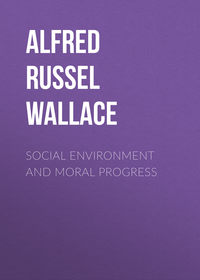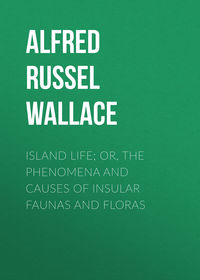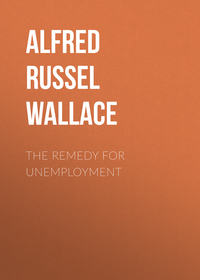 полная версия
полная версияThe Malay Archipelago, Volume 2
The morning after I had got into my new house, I sent my boys out to shoot, and went myself to explore the road to the coal mines. In less than half a mile it entered the virgin forest, at a place where some magnificent trees formed a kind of natural avenue. The first part was flat and swampy, but it soon rose a little, and ran alongside the fine stream which passed behind my house, and which here rushed and gurgled over a rocky or pebbly bed, sometimes leaving wide sandbanks on its margins, and at other places flowing between high banks crowned with a varied and magnificent forest vegetation. After about two miles, the valley narrowed, and the road was carried along the steep hill-side which rose abruptly from the water's edge. In some places the rock had been cut away, but its surface was already covered with elegant ferns and creepers. Gigantic tree-ferns were abundant, and the whole forest had an air of luxuriance and rich variety which it never attains in the dry volcanic soil to which I had been lately accustomed. A little further the road passed to the other side of the valley by a bridge across the stream at a place where a great mass of rock in the middle offered an excellent support for it, and two miles more of most picturesque and interesting road brought me to the mining establishment.
This is situated in a large open space, at a spot where two tributaries fall into the main stream. Several forest-paths and new clearings offered fine collecting grounds, and I captured some new and interesting insects; but as it was getting late I had to reserve a more thorough exploration for future occasions. Coal had been discovered here some years before, and the road was made in order to bring down a sufficient quantity for a fair trial on the Dutch steamers. The quality, however, was not thought sufficiently good, and the mines were abandoned. Quite recently, works had been commenced in another spot, in Hopes of finding a better vein. There ware about eighty men employed, chiefly convicts; but this was far too small a number for mining operations in such a country, where the mere keeping a few miles of road in repair requires the constant work of several men. If coal of sufficiently good quality should be found, a tramroad would be made, and would be very easily worked, owing to the regular descent of the valley.
Just as I got home I overtook Ali returning from shooting with some birch hanging from his belt. He seemed much pleased, and said, "Look here, sir, what a curious bird," holding out what at first completely puzzled me. I saw a bird with a mass of splendid green feathers on its breast, elongated into two glittering tufts; but, what I could not understand was a pair of long white feathers, which stuck straight out from each shoulder. Ali assured me that the bird stuck them out this way itself, when fluttering its wings, and that they had remained so without his touching them. I now saw that I had got a great prize, no less than a completely new form of the Bird of Paradise, differing most remarkably from every other known bird. The general plumage is very sober, being a pure ashy olive, with a purplish tinge on the back; the crown of the head is beautifully glossed with pale metallic violet, and the feathers of the front extend as much over the beak as inmost of the family. The neck and breast are scaled with fine metallic green, and the feathers on the lower part are elongated on each side, so as to form a two-pointed gorget, which can be folded beneath the wings, or partially erected and spread out in the same way as the side plumes of most of the birds of paradise. The four long white plumes which give the bird its altogether unique character, spring from little tubercles close to the upper edge of the shoulder or bend of the wing; they are narrow, gentle curved, and equally webbed on both sides, of a pure creamy white colour. They are about six inches long, equalling the wing, and can be raised at right angles to it, or laid along the body at the pleasure of the bird. The bill is horn colour, the legs yellow, and the iris pale olive. This striking novelty has been named by Mr. G. R. Gray of the British Museum, Semioptera Wallacei, or "Wallace's Standard wing."
A few days later I obtained an exceedingly beautiful new butterfly, allied to the fine blue Papilio Ulysses, but differing from it in the colour being of a more intense tint, and in having a row of blue stripes around the margin of the lower wings. This good beginning was, however, rather deceptive, and I soon found that insects, and especially butterflies, were somewhat scarce, and birds in tar less variety than I had anticipated. Several of the fine Moluccan species were however obtained. The handsome red lory with green wings and a yellow spot in the back (Lorius garrulus), was not uncommon. When the Jambu, or rose apple (Eugenic sp.), was in flower in the village, flocks of the little lorikeet (Charmosyna placentis), already met with in Gilolo, came to feed upon the nectar, and I obtained as many specimens as I desired. Another beautiful bird of the parrot tribe was the Geoffroyus cyanicollis, a green parrot with a red bill and head, which colour shaded on the crown into azure blue, and thence into verditer blue and the green of the back. Two large and handsome fruit pigeons, with metallic green, ashy, and rufous plumage, were not uncommon; and I was rewarded by finding a splendid deep blue roller (Eurystomus azureus); a lovely golden-capped sunbird (Nectarinea auriceps), and a fine racquet-tailed kingfisher (Tanysiptera isis), all of which were entirely new to ornithologists. Of insects I obtained a considerable number of interesting beetles, including many fine longicorns, among which was the largest and handsomest species of the genus Glenea yet discovered. Among butterflies the beautiful little Danis sebae was abundant, making the forests gay with its delicate wings of white and the richest metallic blue; while showy Papilios, and pretty Pieridae, and dark, rich Euphaeas, many of them new, furnished a constant source of interest and pleasing occupation.
The island of Batchian possesses no really indigenous inhabitants, the interior being altogether uninhabited; and there are only a few small villages on various parts of the coast; yet I found here four distinct races, which would wofully mislead an ethnological traveller unable to obtain information as to their origin, first there are the Batchian Malays, probably the earliest colonists, differing very little from those of Ternate. Their language, however, seems to have more of the Papuan element, with a mixture of pure Malay, showing that the settlement is one of stragglers of various races, although now sufficiently homogeneous. Then there are the "Orang Sirani," as at Ternate and Amboyna. Many of these have the Portuguese physiognomy strikingly preserved, but combined with a skin generally darker than the Malays. Some national customs are retained, and the Malay, which is their only language, contains a large number of Portuguese words and idioms. The third race consists of the Galela men from the north of Gilolo, a singular people, whom I have already described; and the fourth is a colony from Tomóre, in the eastern peninsula of Celebes. These people were brought here at their own request a few years ago, to avoid extermination by another tribe. They have a very light complexion, open Tartar physiognomy, low stature, and a language of the Bugis type. They are an industrious agricultural people, and supply the town with vegetables. They make a good deal of bark cloth, similar to the tapa of the Polynesians, by cutting down the proper trees and taping off large cylinders of bark, which is beaten with mallets till it separates from the wood. It is then soaked, and so continuously and regularly beaten out that it becomes as thin and as tough as parchment. In this foam it is much used for wrappers for clothes; and they also make jackets of it, sewn neatly together and stained with the juice of another kind of bark, which gives it a dark red colour and renders it nearly waterproof.
Here are four very distinct kinds of people who may all be seen any day in and about the town of Batchian. Now if we suppose a traveller ignorant of Malay, picking up a word or two here and there of the "Batchian language," and noting down the "physical and moral peculiarities, manners, and customs of the Batchian people"—(for there are travellers who do all this in four-and-twenty hours)—what an accurate and instructive chapter we should have' what transitions would be pointed out, what theories of the origin of races would be developed while the next traveller might flatly contradict every statement and arrive at exactly opposite conclusions.
Soon after I arrived here the Dutch Government introduced a new copper coinage of cents instead of doits (the 100th instead of the 120th part of a guilder), and all the old coins were ordered to be sent to Ternate to be changed. I sent a bag containing 6,000 doits, and duly received the new money by return of the boat. Then Ali went to bring it, however, the captain required a written order; so I waited to send again the next day, and it was lucky I did so, for that night my house was entered, all my boxes carried out and ransacked, and the various articles left on the road about twenty yards off, where we found them at five in the morning, when, on getting up and finding the house empty, we rushed out to discover tracks of the thieves. Not being able to find the copper money which they thought I had just received, they decamped, taking nothing but a few yards of cotton cloth and a black coat and trousers, which latter were picked up a few days afterwards hidden in the grass. There was no doubt whatever who were the thieves. Convicts are employed to guard the Government stores when the boat arrives from Ternate. Two of them watch all night, and often take the opportunity to roam about and commit robberies.
The next day I received my money, and secured it well in a strong box fastened under my bed. I took out five or six hundred cents for daily expenses, and put them in a small japanned box, which always stood upon my table. In the afternoon I went for a short walk, and on my return this box and my keys, which I had carelessly left on the table, were gone. Two of my boys were in the house, but had heard nothing. I immediately gave information of the two robberies to the Director at the mines and to the Commandant at the fort, and got for answer, that if I caught the thief in the act I might shoot him. By inquiry in the village, we afterwards found that one of the convicts who was on duty at the Government rice-store in the village had quitted his guard, was seen to pass over the bridge towards my house, was seen again within two hundred yards of my house, and on returning over the bridge into the village carried something under his arm, carefully covered with his sarong. My box was stolen between the hours he was seen going and returning, and it was so small as to be easily carried in the way described. This seemed pretty clear circumstantial evidence. I accused the man and brought the witnesses to the Commandant. The man was examined, and confessed having gone to the river close to my house to bathe; but said he had gone no farther, having climbed up a cocoa-nut tree and brought home two nuts, which he had covered over, because he was ashamed to be seen carrying them! This explanation was thought satisfactory, and he was acquitted. I lost my cash and my box, a seal I much valued, with other small articles, and all my keys-the severest loss by far. Luckily my large cash-box was left locked, but so were others which I required to open immediately. There was, however, a very clever blacksmith employed to do ironwork for the mines, and he picked my locks for me when I required them, and in a few days made me new keys, which I used all the time I was abroad.
Towards the end of November the wet season set in, and we had daily and almost incessant rains, with only about one or two hours' sunshine in the morning. The flat parts of the forest became flooded, the roads filled with mud, and insects and birds were scarcer than ever. On December Lath, in the afternoon, we had a sharp earthquake shock, which made the house and furniture shale and rattle for five minutes, and the trees and shrubs wave as if a gust of wind had passed over them. About the middle of December I removed to the village, in order more easily to explore the district to the west of it, and to be near the sea when I wished to return to Ternate. I obtained the use of a good-sized house in the Campong Sirani (or Christian village), and at Christmas and the New Year had to endure the incessant gun-firing, drum-beating, and fiddling of the inhabitants.
These people are very fond of music and dancing, and it would astonish a European to visit one of their assemblies. We enter a gloomy palm-leaf hut, in which two or three very dim lamps barely render darkness visible. The floor is of black sandy earth, the roof hid in a smoky impenetrable blackness; two or three benches stand against the walls, and the orchestra consists of a fiddle, a fife, a drum, and a triangle. There is plenty of company, consisting of young men and women, all very neatly dressed in white and black—a true Portuguese habit. Quadrilles, waltzes, polkas, and mazurkas are danced with great vigour and much skill. The refreshments are muddy coffee and a few sweetmeats. Dancing is kept up for hours, and all is conducted with much decorum and propriety. A party of this kind meets about once a week, the principal inhabitants taking it by turns, and all who please come in without much ceremony.
It is astonishing how little these people have altered in three hundred years, although in that time they have changed their language and lost all knowledge of their own nationality. They are still in manners and appearance almost pure Portuguese, very similar to those with whom I had become acquainted on the banks of the Amazon. They live very poorly as regards their house and furniture, but preserve a semi-European dress, and have almost all full suits of black for Sundays. They are nominally Protestants, but Sunday evening is their grand day for music and dancing. The men are often good hunters; and two or three times a week, deer or wild pigs are brought to the village, which, with fish and fowls, enables them to live well. They are almost the only people in the Archipelago who eat the great fruit-eating bats called by us "flying foxes." These ugly creatures are considered a great delicacy, and are much sought after. At about the beginning of the year they come in large flocks to eat fruit, and congregate during the day on some small islands in the bay, hanging by thousands on the trees, especially on dead ones. They can then be easily caught or knocked down with sticks, and are brought home by basketsfull. They require to be carefully prepared, as the skin and fur has a rank end powerful foxy odour; but they are generally cooked with abundance of spices and condiments, and are really very good eating, something like hare. The Orang Sirani are good cooks, having a much greater variety of savoury dishes than the Malays. Here, they live chiefly on sago as bread, with a little rice occasionally, and abundance of vegetables and fruit.
It is a curious fact that everywhere in the Past where the Portuguese have mixed with the native races they leave become darker in colour than either of the parent stocks. This is the case almost always with these "Orang Sirani" in the Moluccas, and with the Portuguese of Malacca. The reverse is the case in South America, where the mixture of the Portuguese or Brazilian with the Indian produces the "Mameluco," who is not unfrequently lighter than either parent, and always lighter than the Indian. The women at Batchian, although generally fairer than the men, are coarse in features, and very far inferior in beauty to the mixed Dutch-Malay girls, or even to many pure Malays.
The part of the village in which I resided was a grove of cocoa-nut trees, and at night, when the dead leaves were sometimes collected together and burnt, the effect was most magnificent—the tall stems, the fine crowns of foliage, and the immense fruit-clusters, being brilliantly illuminated against a dark sky, and appearing like a fairy palace supported on a hundred columns, and groined over with leafy arches. The cocoa-nut tree, when well grown, is certainly the prince of palms both for beauty and utility.
During my very first walk into the forest at Batchian, I had seen sitting on a leaf out of reach, an immense butterfly of a dark colour marked with white and yellow spots. I could not capture it as it flew away high up into the forest, but I at once saw that it was a female of a new species of Ornithoptera or "bird-winged butterfly," the pride of the Eastern tropics. I was very anxious to get it and to find the male, which in this genus is always of extreme beauty. During the two succeeding months I only saw it once again, and shortly afterwards I saw the male flying high in the air at the mining village. I had begun to despair of ever getting a specimen, as it seemed so rare and wild; till one day, about the beginning of January, I found a beautiful shrub with large white leafy bracts and yellow flowers, a species of Mussaenda, and saw one of these noble insects hovering over it, but it was too quick for me, and flew away. The next clay I went again to the same shrub and succeeded in catching a female, and the day after a fine male. I found it to be as I had expected, a perfectly new and most magnificent species, and one of the most gorgeously coloured butterflies in the world. Fine specimens of the male are more than seven inches across the wings, which are velvety black and fiery orange, the latter colour replacing the green of the allied species. The beauty and brilliancy of this insect are indescribable, and none but a naturalist can understand the intense excitement I experienced when I at length captured it. On taking it out of my net and opening the glorious wings, my heart began to beat violently, the blood rushed to my head, and I felt much more like fainting than I have done when in apprehension of immediate death. I had a headache the rest of the day, so great was the excitement produced by what will appear to most people a very inadequate cause.
I had decided to return to Ternate in a week or two more, but this grand capture determined me to stay on till I obtained a good series of the new butterfly, which I have since named Ornithoptera croesus. The Mussaenda bush was an admirable place, which I could visit every day on my way to the forest; and as it was situated in a dense thicket of shrubs and creepers, I set my man Lahi to clear a space all round it, so that I could easily get at any insect that might visit it. Afterwards, finding that it was often necessary to wait some time there, I had a little seat put up under a tree by the side of it, where I came every day to eat my lunch, and thus had half an hour's watching about noon, besides a chance as I passed it in the morning. In this way I obtained on an average one specimen a day for a long time, but more than half of these were females, and more than half the remainder worn or broken specimens, so that I should not have obtained many perfect males had I not found another station for them.
As soon as I had seen them come to flowers, I sent my man Lahi with a net on purpose to search for them, as they had also been seen at some flowering trees on the beach, and I promised him half a day's wages extra for every good specimen he could catch. After a day or two he brought me two very fair specimens, and told me he had caught them in the bed of a large rocky stream that descends from the mountains to the sea abort a mile below the village. They flew down this river, settling occasionally on stones and rocks in the water, and he was obliged to wade up it or jump from rock to rock to get at them. I went with him one day, but found that the stream was far too rapid and the stones too slippery for me to do anything, so I left it entirely to him, and all the rest of the time we stayed in Batchian he used to be out all day, generally bringing me one, and on good days two or three specimens. I was thus able to bring away with me more than a hundred of both sexes, including perhaps twenty very fine males, though not more than five or six that were absolutely perfect.
My daily walk now led me, first about half a mile along the sandy beach, then through a sago swamp over a causeway of very shaky poles to the village of the Tomore people. Beyond this was the forest with patches of new clearing, shady paths, and a considerable quantity of felled timber. I found this a very fair collecting ground, especially for beetles. The fallen trunks in the clearings abounded with golden Buprestidae and curious Brenthidae, and longicorns, while in the forest I found abundance of the smaller Curculionidae, many longicorns, and some fine green Carabidae.
Butterflies were not abundant, but I obtained a few more of the fine blue Papilio, and a number of beautiful little Lycaenidae, as well as a single specimen of the very rare Papilio Wallacei, of which I had taken the hitherto unique specimen in the Aru Islands.
The most interesting birds I obtained here, were the beautiful blue kingfisher, Todiramphus diops; the fine green and purple doves, Ptilonopus superbus and P. iogaster, and several new birds of small size. My shooters still brought me in specimens of the Semioptera Wallacei, and I was greatly excited by the positive statements of several of the native hunters that another species of this bird existed, much handsomer and more remarkable. They declared that the plumage was glossy black, with metallic green breast as in my species, but that the white shoulder plumes were twice as long, and hung down far below the body of the bird. They declared that when hunting pigs or deer far in the forest they occasionally saw this bird, but that it was rare. I immediately offered twelve guilders (a pound) for a specimen; but all in vain, and I am to this day uncertain whether such a bird exists. Since I left, the German naturalist, Dr. Bernstein, stayed many months in the island with a large staff of hunters collecting for the Leyden Museum; and as he was not more successful than myself, we must consider either that the bird is very rare, or is altogether a myth.
Batchian is remarkable as being the most eastern point on the globe inhabited by any of the Quadrumana. A large black baboon-monkey (Cynopithecus nigrescens) is abundant in some parts of the forest. This animal has bare red callosities, and a rudimentary tail about an inch long—a mere fleshy tubercle, which may be very easily overlooked. It is the same species that is found all over the forests of Celebes, and as none of the other Mammalia of that island extend into Batchian I am inclined to suppose that this species has been accidentally introduced by the roaming Malays, who often carry about with them tame monkeys and other animals. This is rendered more probable by the fact that the animal is not found in Gilolo, which is only separated from Batchian by a very narrow strait. The introduction may have been very recent, as in a fertile and unoccupied island such an animal would multiply rapidly. The only other mammals obtained were an Eastern opossum, which Dr. Gray has described as Cuscus ornatus; the little flying opossum, Belideus ariel; a Civet cat, Viverra zebetha; and nice species of bats, most of the smaller ones being caught in the dusk with my butterfly net as they flew about before the house.
After much delay, owing to bad weather and the illness of one of my men, I determined to visit Kasserota (formerly the chief village), situated up a small stream, on an island close to the north coast of Batchian; where I was told that many rare birds were found. After my boat was loaded and everything ready, three days of heavy squalls prevented our starting, and it was not till the 21st of March that we got away. Early next morning we entered the little river, and in about an hour we reached the Sultan's house, which I had obtained permission to use. It was situated on the bank of the river, and surrounded by a forest of fruit trees, among which were some of the very loftiest and most graceful cocoa-nut palms I have ever seen. It rained nearly all that day, and I could do little but unload and unpack. Towards the afternoon it cleared up, and I attempted to explore in various directions, but found to my disgust that the only path was a perfect mud swamp, along which it was almost impossible to walk, and the surrounding forest so damp and dark as to promise little in the way of insects. I found too on inquiry that the people here made no clearings, living entirely on sago, fruit, fish, and game; and the path only led to a steep rocky mountain equally impracticable and unproductive. The next day I sent my men to this hill, hoping it might produce some good birds; but they returned with only two common species, and I myself had been able to get nothing; every little track I had attempted to follow leading to a dense sago swamp. I saw that I should waste time by staying here, and determined to leave the following day.









